A notice came today indicating that the post office is holding a parcel for me. That must be the Henry Poole coat so I had better get the Huntsman finished!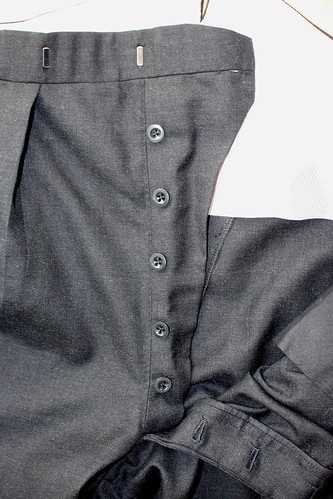
This suit was cut for a very short man, but in typical English fashion, the trouser is cut with a very high rise and a fishtail back. Intended to be worn only with suspenders (or braces, as they would refer to them), the waist is cut very high, there are no belt loops, and the fly closes with buttons. It looks just like a page out of a tailoring manual from the turn of the last century. It's actually charming!
Here you can see just how long the rise was cut, even for this very short man the square extends only to the bottom of the fly- not all the way to the inseam, which is a few inches further.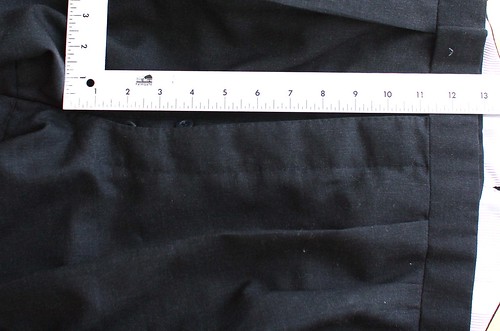
Notice how the back is cut very high, without a separate waistband, in order to accommodate the suspenders. 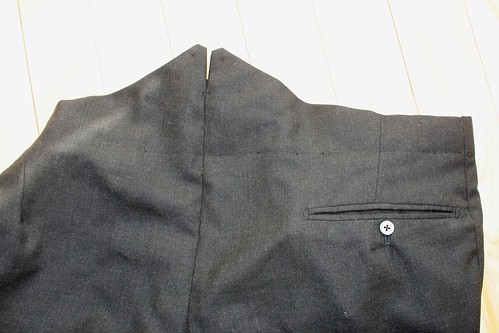
The front has been cut with a waistband to allow for two forward pleats and the pick stitching of the pocket is barely visible.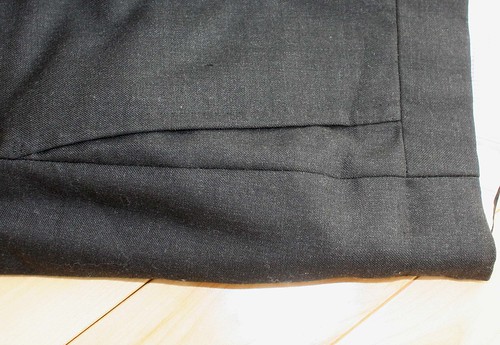
Instead of a bulky seam, the pocket edge has been turned under, having been reinforced by a piece of linen, and finished by hand.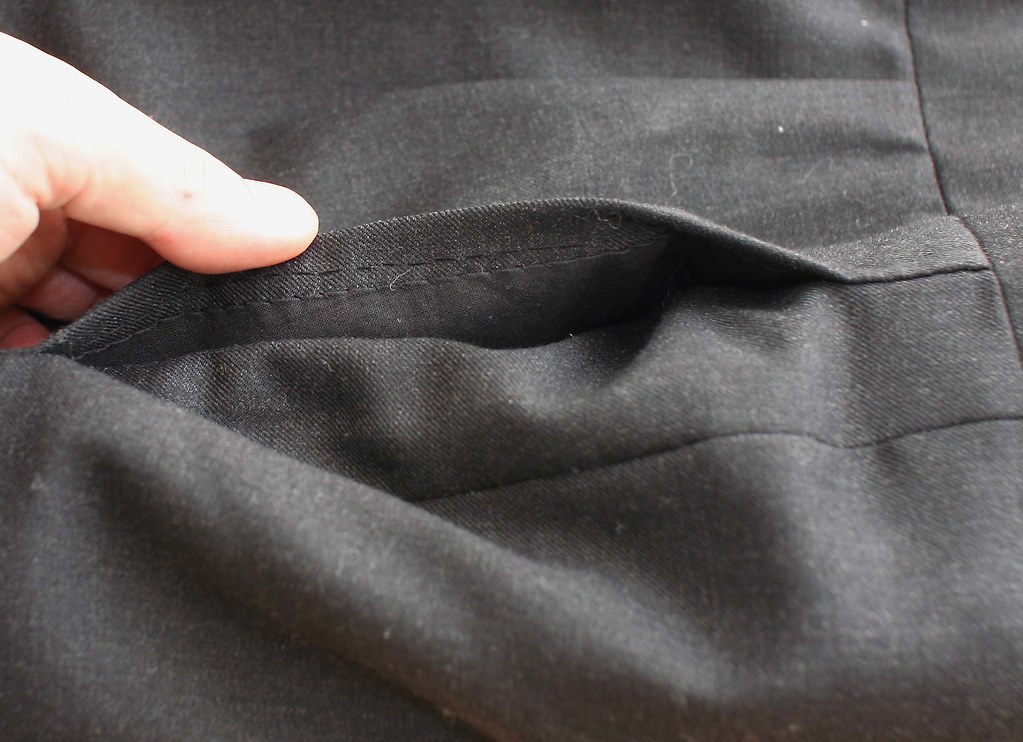
The pocket inside has been finished by hand, as has all the curtain and facings. The facing has been felled to the pocketing by hand, and you can see the enormous inlays left at the outseam. The trouser had been altered, probably at the final fitting as a previous seam line is evident. but even the original inlays were pretty big, allowing for considerable weight gain.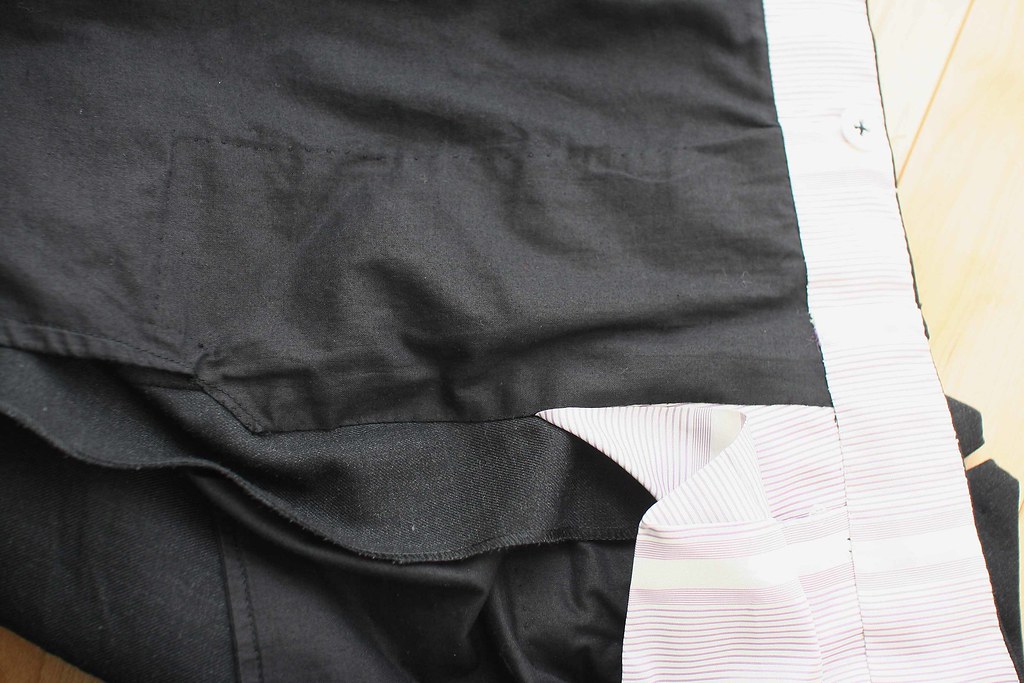
A bigger view of the outseam. Generous inlays have also been allowed at the inseam.
The waistband has been finished by hand, using a large piece of lining folded over three times.
The back of the trouser is finished with the same lining, leaving ample pleats in the curtain to allow for future alterations.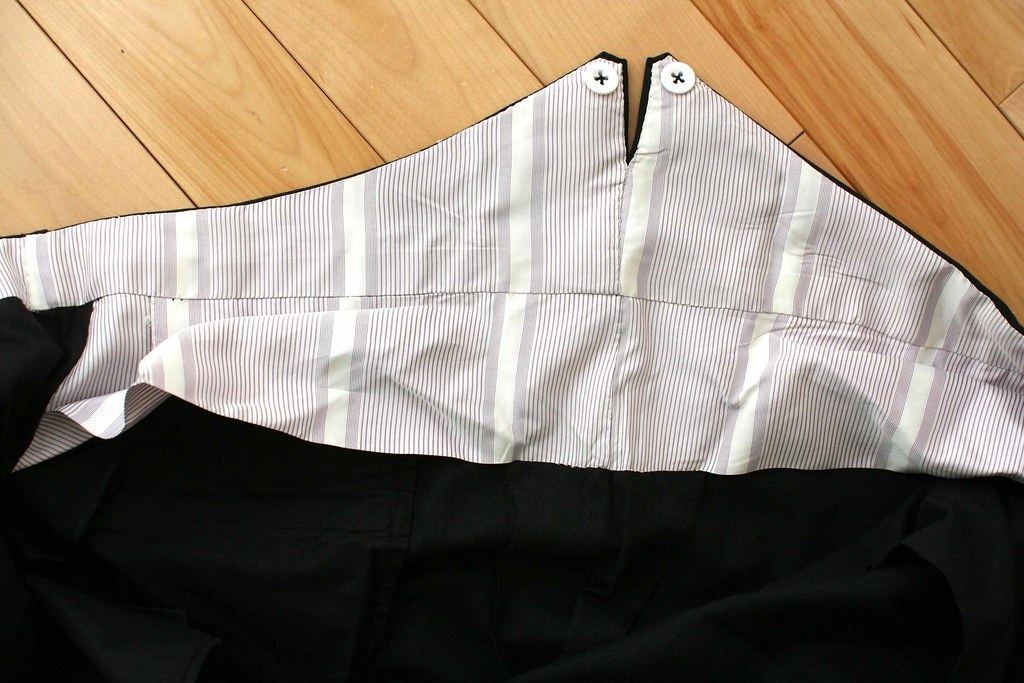
Here you can see how the back was reinforced with linen prior to finishing. A lot of extra cloth has to be folded in to allow to rebuild the points if the trouser has to be let out or taken in (one of the minor drawbacks to this style is the amount of work required to do what is otherwise a simple alteration.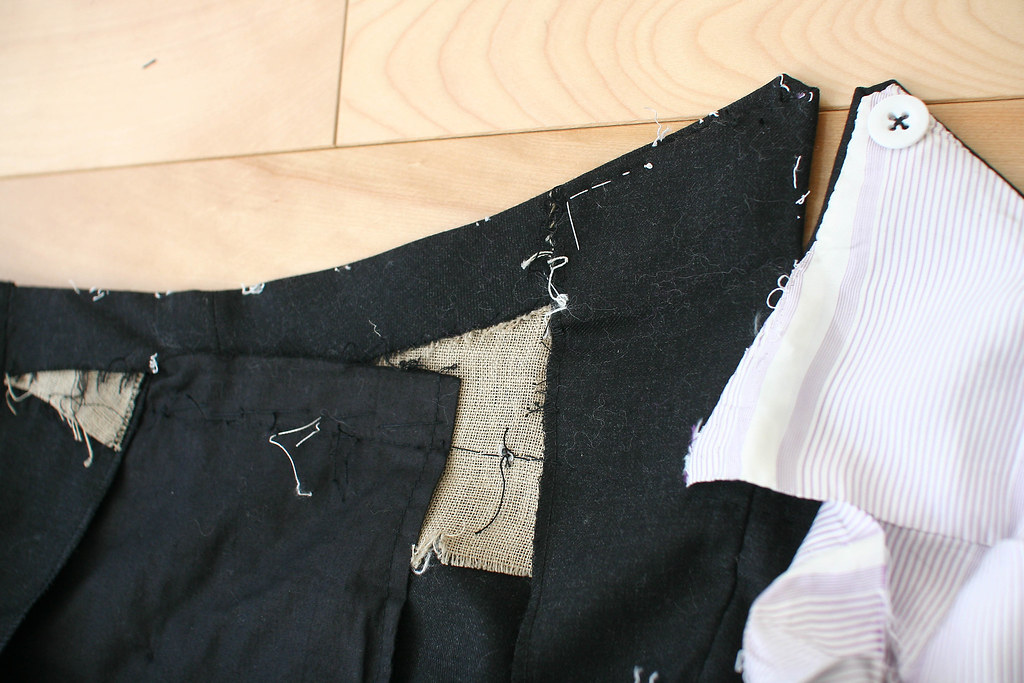
The front of the waistband was done in a smart way which will deserve a post of its own to explain how it was done, as I think this will interest home sewers. The banroll was attached to a piece of linen and the two were attached to the double width waistband cloth in such a way as to make it very stable and prevent shifting, and the edges of the cloth meet up neatly to create a smooth, even finish. Notice the inlays left at the waist to allow the waist to be raised even further.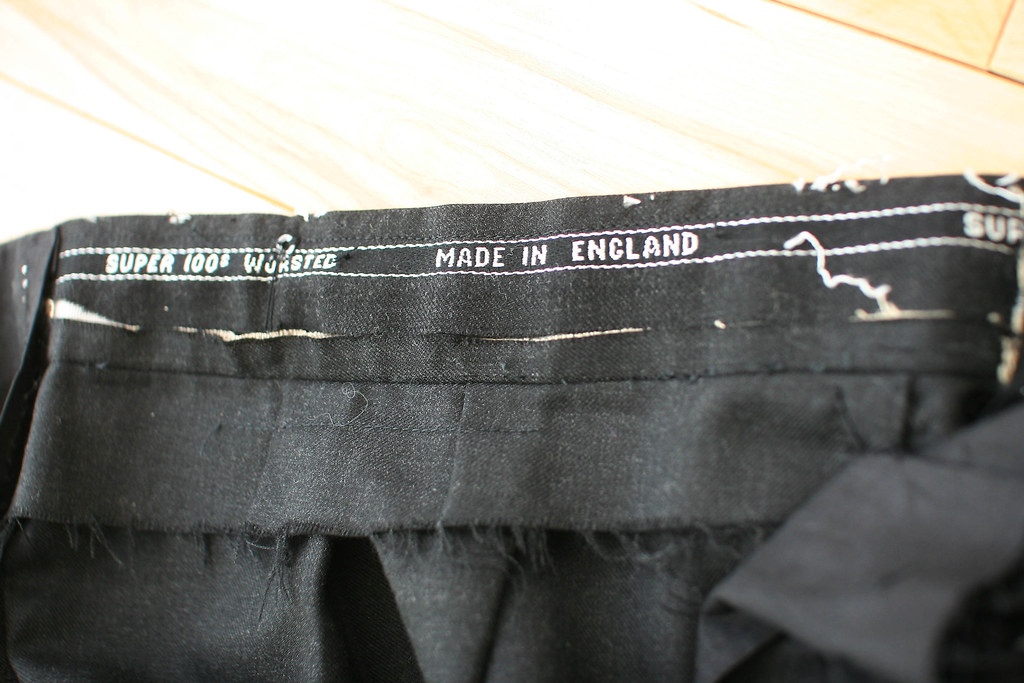
The seat seam has been sewn by hand, which brings me to a point I keep trying to make.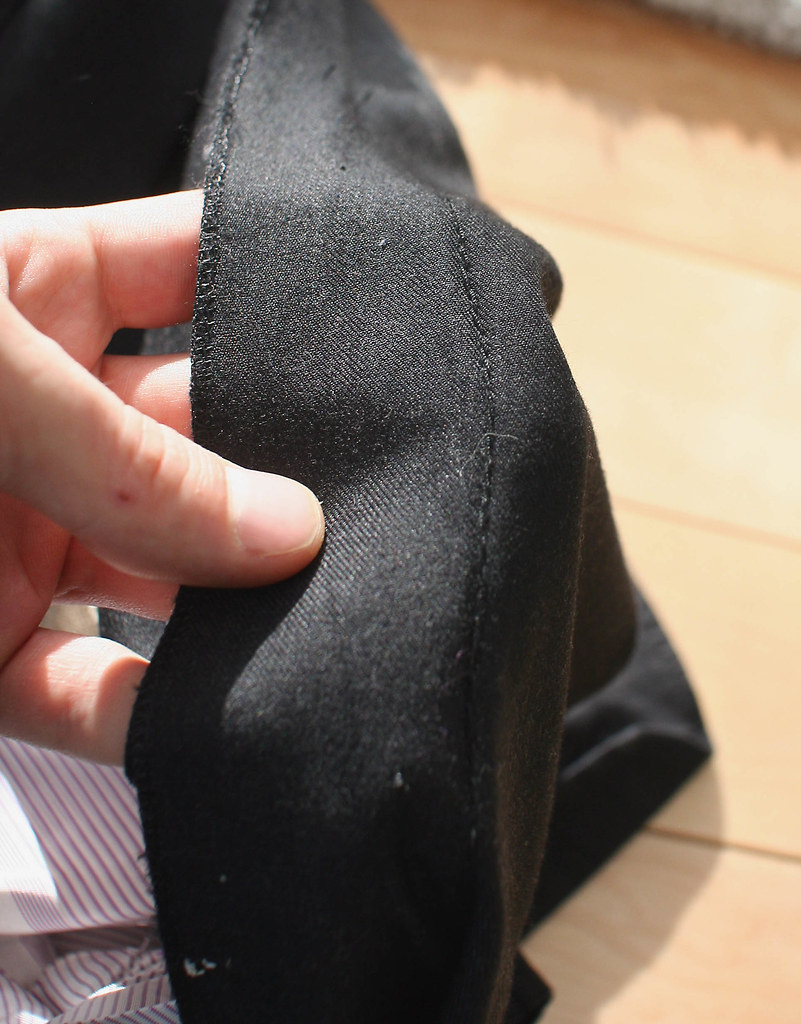
ON RECEIVED WISDOM
As we can see in this trouser, a lot of the craft of tailoring has changed little in the last hundred years. More. A lot of the basic truths have also been repeated, without changing, over that period of time. It's almost religious. One of the maxims is about the hand-sewn seam and its flexibility-
A hand-sewn seam has give and a machine-sewn seam does not, therefore a hand-sewn seam is superior to a machine-sewn seam.
Let's put that in context. A hundred years ago, the only machine available to tailors was the plain machine, more correctly known as the lock stitch machine, because two threads interlock to form a stitch, and a series of those stitches for a seam. It is strong and has very little give, so in an area subject to strain, such as the seat of the trouser, a lock-stitch seam could break easily. A tailor, however, could sew the seam using a back-stitch, a stitch which loops back over itself, which allow the seam to stretch a fair bit. In this context, the above statement is entirely true- a hand-sewn seam is better than a lockstitch seam. We hear this in reference to seat seams, shoulder seams, sleeve seams, and more.....
Though many things have not changed, and tailors are justly proud of the tradition we have maintained, technology HAS changed since then. There are now machines which not only replicate that looping hand stitch but better it, creating complex looping chainstitches with one or several threads which are far more flexible and strong than any hand-sewn backstitch. Those machines can be expensive, though, so most tailor shops will not bother with the expense of such a machine which is only good for 3 or 4 of the hundreds of operations involved in making a suit. My guess is that many of the tailors who chant the mantra of the hand stitch have never seen a lot of the equipment available today. And even though you will hear it repeated often that hand-sewn seams are superior, if you look inside what you thought was a very well-made pant and see that the seat seam has been done by some sort of machine, do not feel that you been been short-changed because the seam was not done by hand. In fact, it is likely that the seam is much stronger than a hand-sewn seam.
So before you go blindly repeating the received wisdom about the hand-sewn seam, know that while it was once quite true, and that it is still true in certain contexts (like that of a small tailor shop, equipped only with lock-stitch machines), it is certainly no longer entirely true. It is nice to know your garment was crafted entirely by hand, but is no longer strictly necessary in order to achieve the same degree of quality, or better, in this instance.
Rant over.








10 comments:
YOu say the trousers were made for a short man. How short? What're the approximate measurements of them? (Waist and inseam?) I'm 6' tall, and a rise like that would well above my belly button. (I'm wondering how much of the rise was used in climbing a belly, basically). And, since I'm asking what are the measurements of the jacket?
Thanks. I really enjoy your deconstructions.
Your rant raises food for thought. When the dissections of the A&S and Poole garments are completed, give some thought to writing a piece about the pros and cons of bespoke clothing versus the kind made by, say, Oxxford Clothes or some of the other makers still standing.
Happy holidays, Jeffery, and all the best for the New Year!
JMB
The suit was cut for a generously-proportioned person- the inseam is 25 1/2", the trouser waist s 43". I'll measure the coat later today but IIRC, the sleeves are quite short compared to the length o the coat, which is on the long side.
Jordan, you are hitting on something that may not be so easy to cover in a simple essay, but which I am hoping may reveal itself over the course of many. But you are quite right- food for thought.
Happy holidays to you, and to all readers as well!
Best wishes for a happy, healthy and prosperous New Year!
Jeffery
A disadvantage of the seams sewn by a chain stitch machine is that you only need the thread in one place to give way and the whole seam unzips, as happened to me today. I picked at what I thought was just a loose thread and pulled the entire seam out. Very annoying.
Rob
I think I made those trousers when I worked for Henry Poole, as I was the only one to hand stitch the back seam!
Thank you for your post
Man Suit Tailor near me
Same Day Alteration near me
Nurses in Saudi Arabia are offered competitive tax-free salaries, generally ranging between $2,500 and $4,000 monthly. Compensation varies depending on experience, area of specialization, and the healthcare institution's reputation. Comprehensive benefit packages typically accompany these salaries, including housing allowances, health insurance, and annual paid leave. Opportunities for overtime and additional shifts offer potential for increased earnings. Experienced or specialized nurses might secure even higher salaries, reflecting their expertise. The enticing financial package, combined with world-class medical facilities and the opportunity to gain international experience, makes Saudi Arabia a desirable destination for many nursing professionals.
https://www.dynamichealthstaff.com/nurse-salary-in-saudi-arabia
Fabulos
Good!
appreciated
Post a Comment